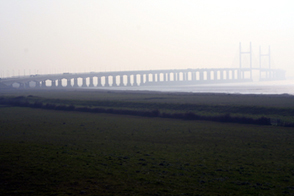Historic Landscape
Characterisation
The Gwent Levels
12 Caldicot fen-edge
12 Caldicot fen-edge character area: unusual area of small
irregular fields by the fen-edge.
(Photo: GGAT Gwent Levels 006)
Click here for a character
area map
The first documentary references to this area are early thirteenth century, making these some of the earliest documented meadows on the Gwent Levels. The enclosure of these open fields and small commons started around the sixteenth century, and was completed in the nineteenth century.
A Roman settlement, enclosed by several substantial ditches, lies by the fen-edge at Stoop Hill. Caldicot was also an important pottery-producing centre, and kilns have been found close to the edge of the alluvium.
In terms of the historic landscape, these areas have some of the earliest documentary references to reclaimed meadows on the Levels, dating back to the thirteenth century (ie Temple Mead).
Key historic landscape characteristics
Small irregular shaped fields result of piecemeal reclamation these
include the important well-documented "Temple Mead", sinuous
droveways, and small parcels of common, historic associations
This is an area of reclamations that fringe the fen-edge around Caldicot village. Rounded by Ifton Reen to the west (area 11).
This is a landscape of small irregular shaped fields, sinuous droveways and small parcels of common. These areas were carved out of the common moor (area 11) in a gradual and piecemeal fashion; one such individual episode is represented by the roughly oval area defined in the field-boundary pattern, by the sea wall to the south of Rogiet. This was "Temple Mead" documented in the thirteenth century.
There were no settlements. Early air photographs show some of the finest "ridge and furrow" resulting from medieval ploughing, on the Gwent Levels (since destroyed). No fields survive with ridging/surface drainage.
Though "irregular landscape" of this type is found widely on the higher coastal areas further west, it is unusual to find it adjacent to the fen-edge. Early documentary evidence, and the survival of Temple Mead enhance the importance of the landscape.
The value of what little survives is diminished by the presence of the
Second Severn Crossing and urban/industrial development around Caldicot.
However, the coherence and integrity of "Temple Mead" is high.
